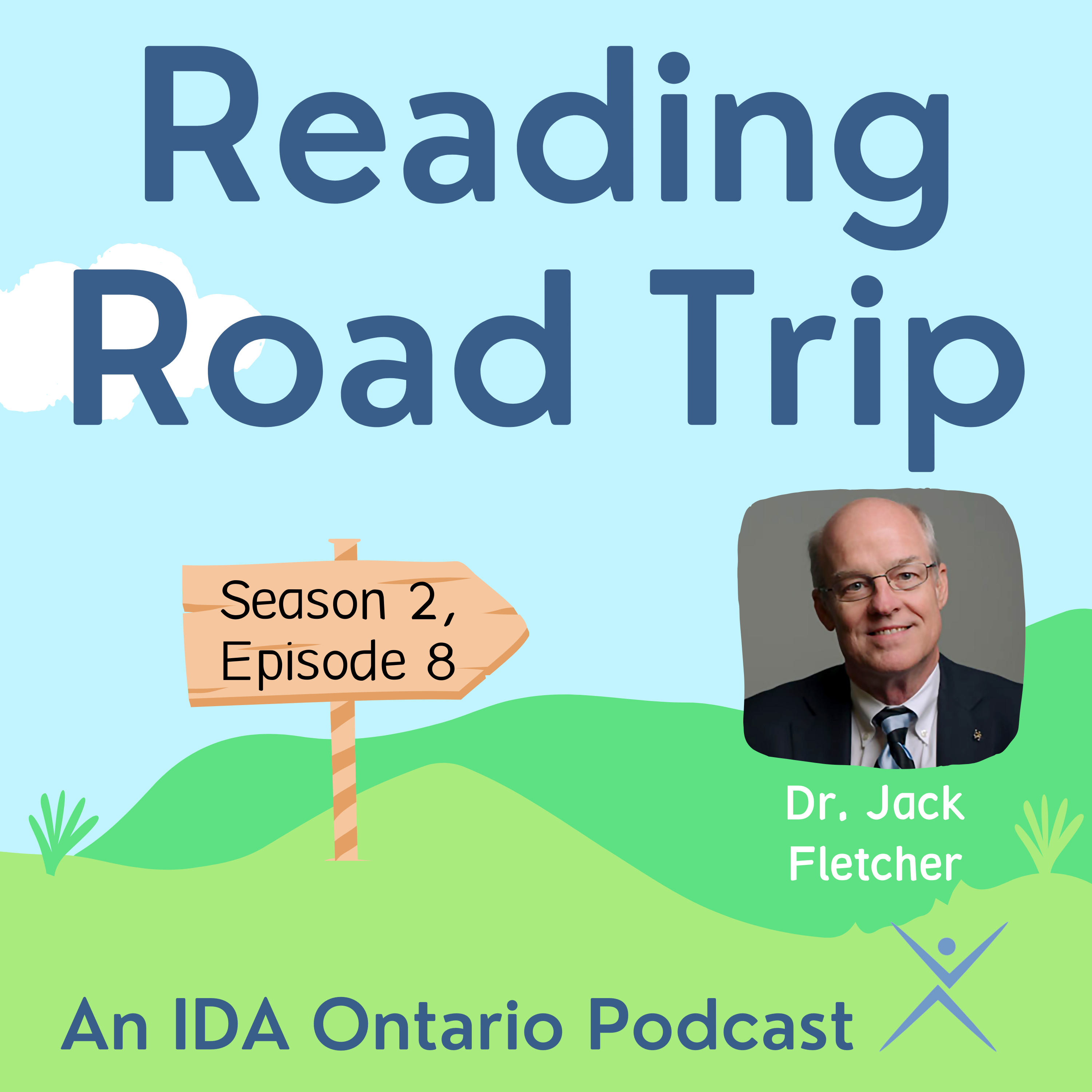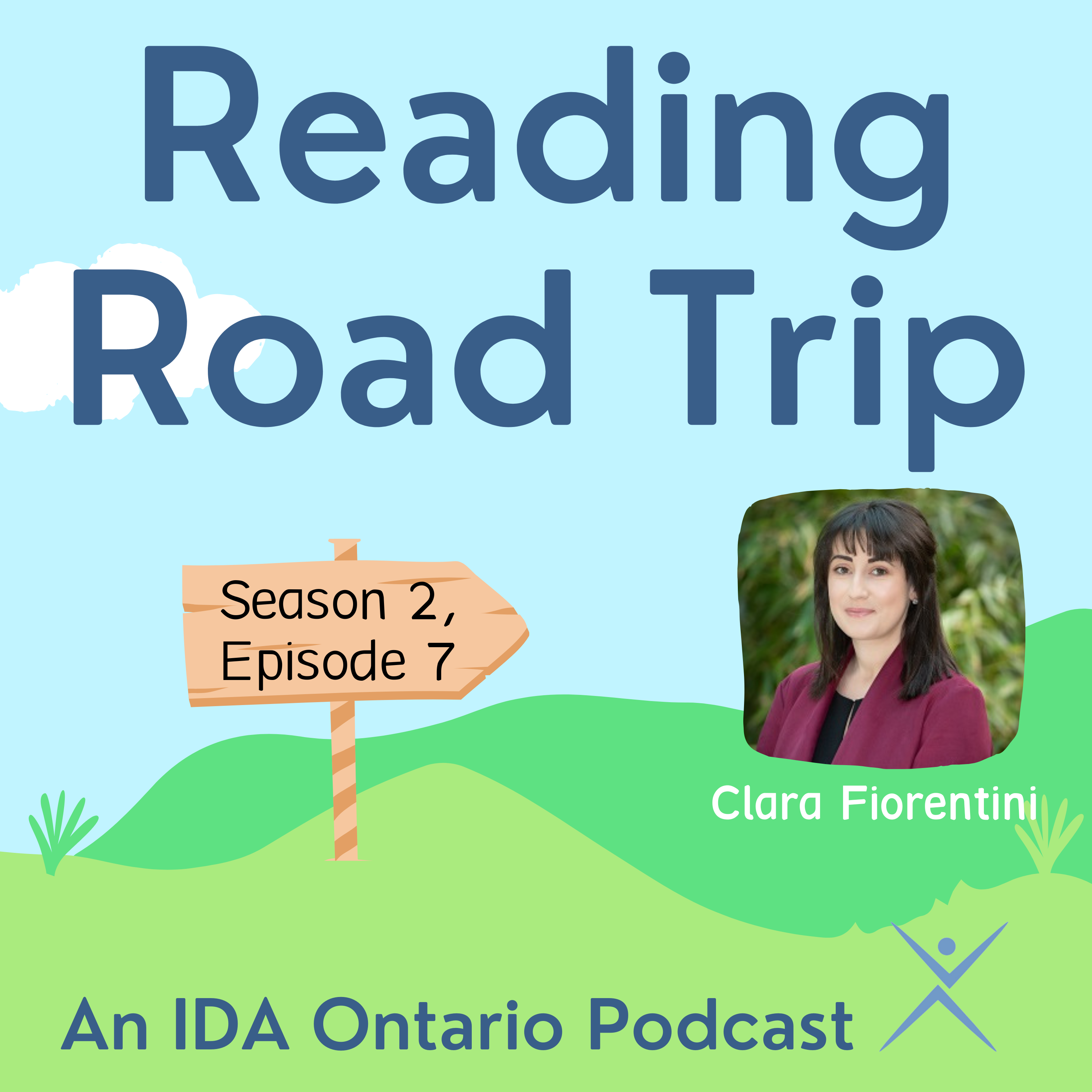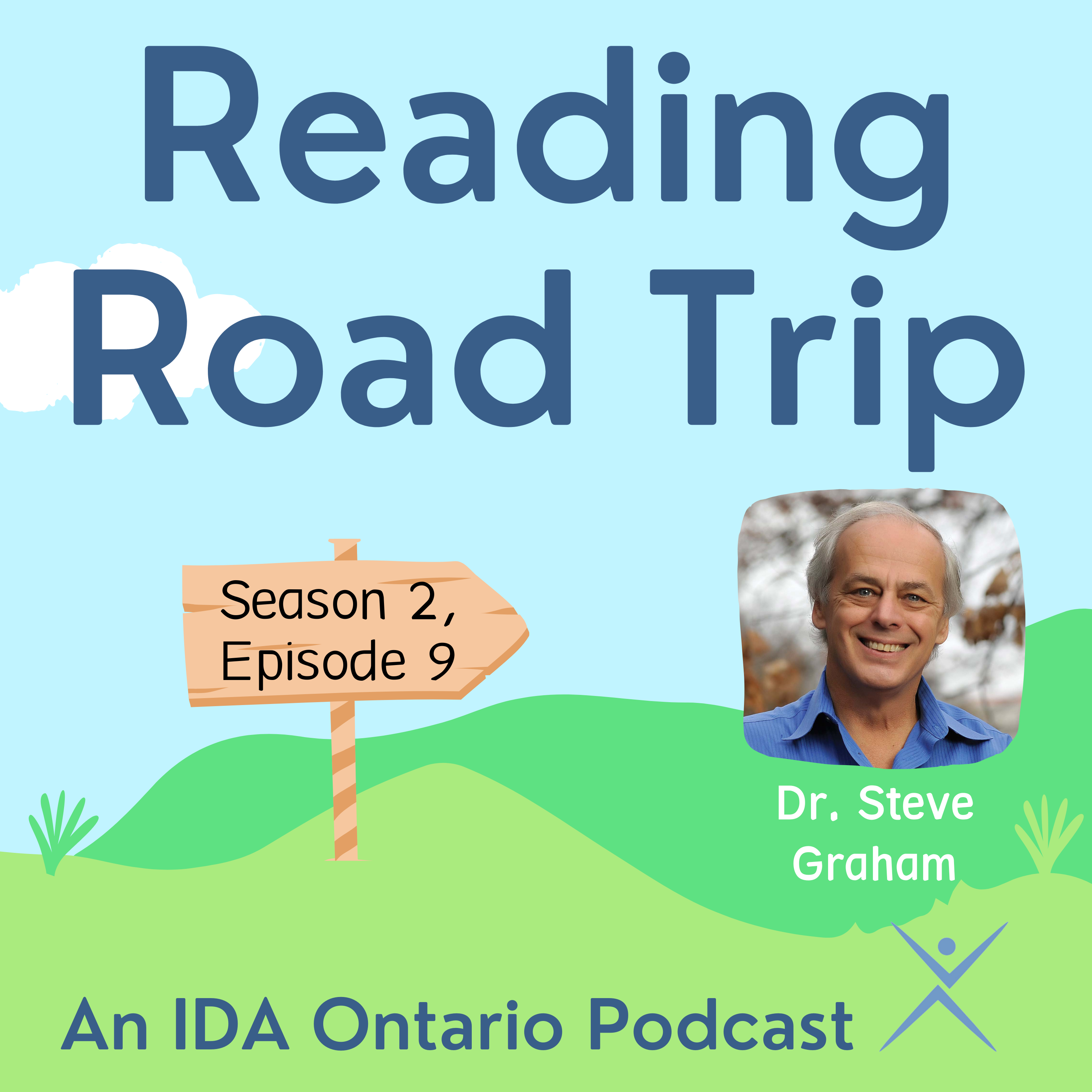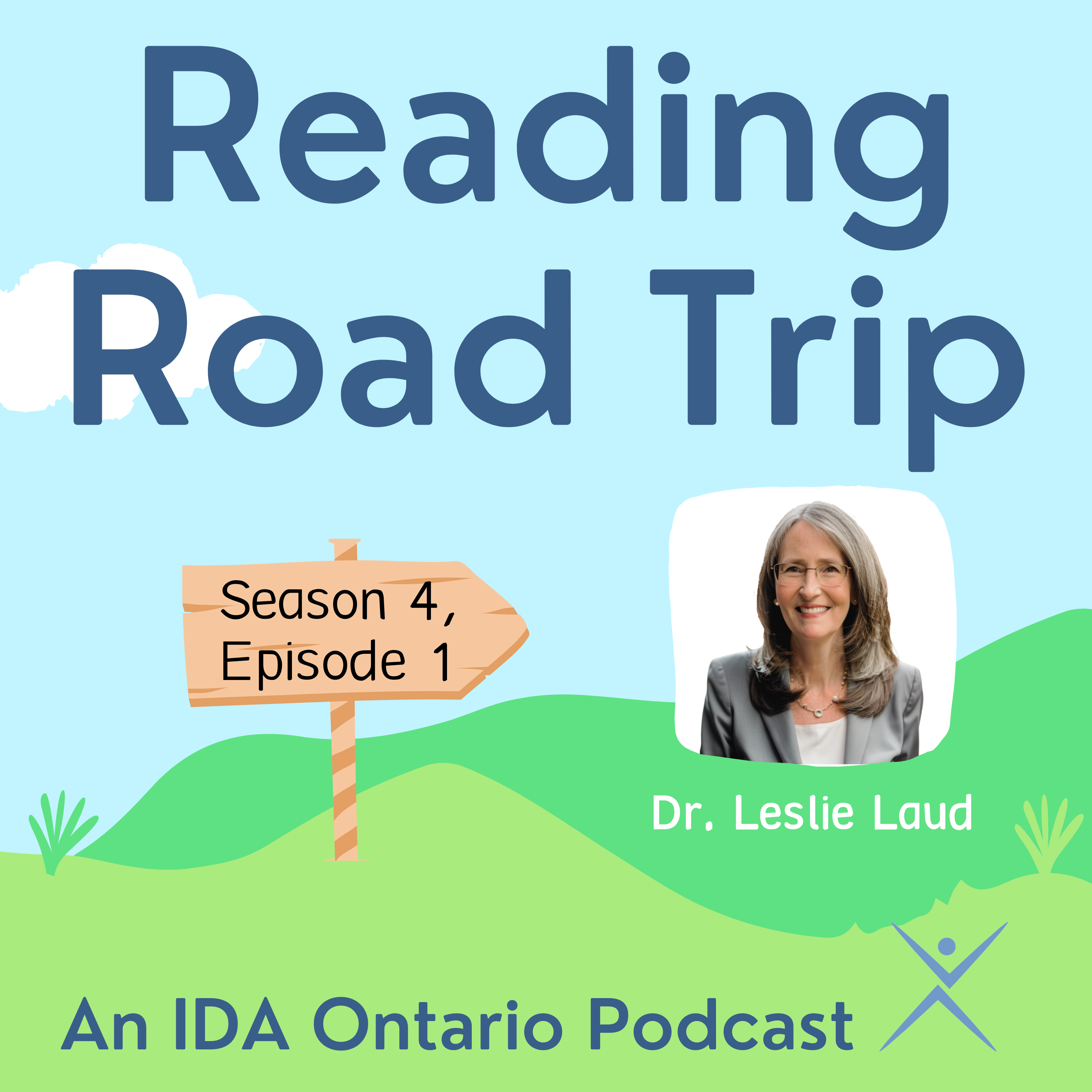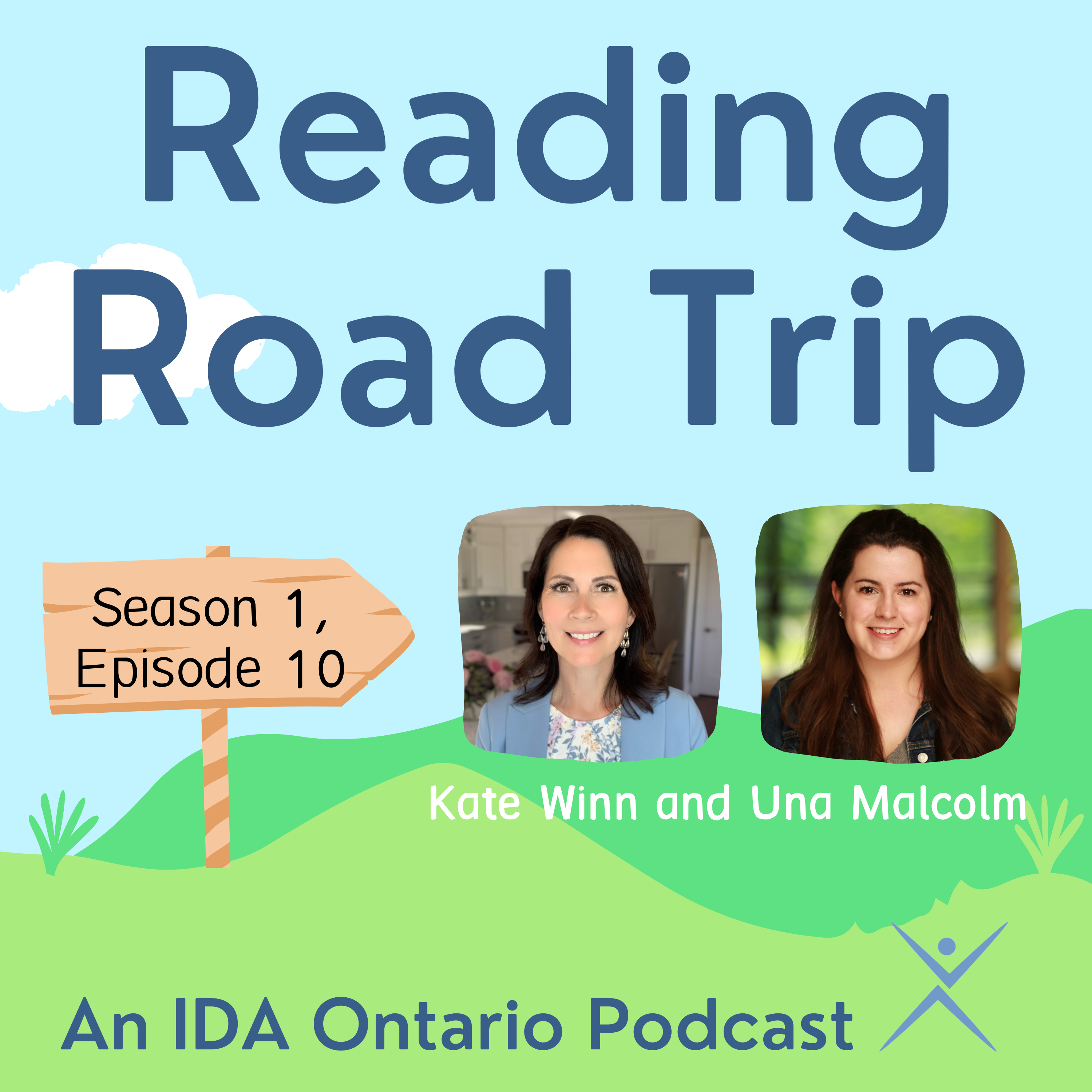Episode Transcript
[00:00:05] Kate Winn: Hello to all you travelers out there on the road to evidence-based literacy instruction. I'm Kate Winn, classroom teacher and host of IDA Ontario's podcast Reading Road Trip.
[00:00:16] Kate Winn: Welcome to the show.
[00:00:17] Kate Winn: We are so excited to be bringing you episode eight of our second season.
Before we get started, we would like to acknowledge that we are recording this podcast from the traditional land of the Mississauga Anishinaabe. We are grateful to live here and thank the generations of First Nations people for their care for and teachings about the earth. We also recognize the contributions of Métis, Inuit and other Indigenous peoples in shaping our community and country.
Along with this acknowledgement, and in the spirit of truth and reconciliation, we would like to amplify the work of an Indigenous author. And this week we are sharing Maakusie Loves Music by Jaaji and Chelsea June of Twin Flames. Maakusie loves music, but what makes music in the Arctic so special? Join Maakusie as he practices throat singing and learn songs, drumming and more. Explore everything from traditional instruments to dances to the origin of the brass bands in the Arctic today. Grab your instruments or sing along. This journey through the history of music in the Arctic is sure to get your toes tapping. Written by renowned Canadian indie rock duo Chelsea June and Jaaji of Twin Flames, this vibrant and engaging book introduces young readers to the exciting world of traditional and modern Inuit music.
Add this book to your home or classroom library today. And now on with the show.
[00:01:41] Kate Winn: It is such a pleasure to introduce our guest for this week's episode of Reading Road Trip. Dr. Jack Fletcher is the Hugh Roy and Lillie Cranz Cullen
distinguished University professor of psychology at the University of Houston. Dr. Fletcher, a child neuropsychologist, has conducted research on many issues related to dyslexia and other learning disabilities, including definition and classification, neurobiological correlates, and intervention. Dr. Fletcher has written more than 400 articles in peer-reviewed journals. I think it is fair to say he is an expert on this topic, and he is here today to share this expertise related to dyslexia. Welcome, Dr. Fletcher.
[00:02:20] Dr. Jack Fletcher: Thank you. It's a pleasure to be here.
[00:02:22] Kate Winn: Just so we're all on the same page, before we get into this big topic, how do you define dyslexia?
[00:02:29] Dr. Jack Fletcher: Well, my approach to definition is pretty simple.
I define dyslexia as a reading problem that occurs at the word level. It's a problem with identifying words and spelling words in isolation.
[00:02:47] Kate Winn: Okay. Is there a cause of dyslexia and what are the risk factors for it?
[00:02:52] Dr. Jack Fletcher: Well, it's hard to say that there's a cause, and there are certainly multiple risk factors. It doesn't boil down to a single cause. I think what's really misleading when people talk about causes is they want to make cause sort of a binary variable. It's either biological or environmental. Well, we know that the proximal causes of dyslexia certainly involve the brain, and there are genetic factors that make brains at risk so that some kids are harder to teach than others. And it's harder for, I'd say, about 40% of kids to really learn to read without really explicit and fairly intense instruction.
So when we talk about causes, what we tend to do is to underemphasize the role of the environment, and particularly the home literacy environment and the instructional environment. We know, for example, that learning to read is not a natural process. We're not born with areas of the brain that are evolutionarily predestined as reading centers. What happens instead is that by essentially requiring kids to learn to read, the brain reorganizes and builds on areas of the brain that are responsible for language and certain types of visual processing, not spatial processing and not vision, but really sort of a computational type of visual processing. If the brain does not receive that kind of experience, it doesn't develop its capacity as a mediator of reading. And so it's really essential, when we talk about dyslexia, to understand that dyslexia is a combination of both biological and environmental factors that put you at risk. And a lot of the risk can be ameliorated through certain types of literacy and language experiences, and in particular, through explicit instruction.
[00:05:19] Kate Winn: And that kind of ties into the next question. So, I once heard you say that dyslexia can often be prevented. Can you discuss what you mean by that, and what are some things we can do to set kids up as best we can?
[00:05:30] Dr. Jack Fletcher: Well, people often misunderstand what I mean when I say that. They think I'm saying that the only cause of dyslexia is environmental and involves instruction, and that kids with dyslexia don't have other kinds of problems, like with writing or ADHD or something like that, because dyslexia itself is a complicated sort of problem. But when I use the term dyslexia, I'm referring specifically to the reading problem. And I believe that the reading problem in many children can be prevented if children receive the type of instruction they need early in development, particularly in kindergarten, first grade, and second grade. And there are multiple explanations for that.
One is to simply understand that in order to develop the neural systems that you need to learn to read, the brain needs repeated exposures to words and text, and that allows you to develop automatic word recognition, so that if you look at a word, you know what it is, and you may know the meaning as well, almost instantaneously. But to do that, the brain has to understand the alphabetic principle that words represent the sounds that we process in language. And dyslexia emerges because of that problem.
Kids can't relate sound and print. It starts with a difficulty relating, understanding the phonetic structure of language. It extends to print when you're exposed to print.
And then because the child doesn't understand this relation of sound and print, that's the alphabetic principle. The underlying problem is what we call phonological awareness. The child can't access print. They can't read the words on the page or spell them. And because of that, the brain does not get the reading experience that it needs to develop this other neural system that you need in order to learn to read. So if we teach kids intensively who are at risk really early, we can give them early access to print, and the brain has an opportunity to obtain the kind of visual experience that it needs in order to become an automatic reader. If we go through three or four years of schooling and the child is not able to access print because they can't read adequately, it's very difficult to catch up in terms of reading experience and reading vocabulary. And so the neural system is never fully developed, and the child has a persistent reading problem.
In older kids, we might be able to teach them to decode adequately, but it's very hard to teach them to decode automatically, much less to read text automatically.
And so the key to dyslexia is early intervention. If we give kids explicit, intensive instruction early in development, when they show risk signs, like a failure to appreciate letter sound relations, very early problems with rhyming, broader things like early language difficulties, if we can identify these risk factors, get kids in intervention early, we can prevent this problem with access to print. And so outcomes are much better for early intervention compared to remediation.
In some very nice studies done in the general education classroom by Carol Connor and in the remedial context by Maureen Lovett, they found that intervention in first and second grade was twice as effective as intervention that occurred after the third grade. And the reason is basically how the brain develops. In order to support the reading brain.
[00:09:53] Kate Winn: We sometimes hear the term specific learning disorder used as a diagnosis. How is that the same as or different from dyslexia?
[00:10:02] Dr. Jack Fletcher: Well, specific learning disorder is an umbrella term that refers to different kinds of learning disabilities. There are multiple learning disabilities in reading. There's dyslexia, which is by far the most common. But you can also have a reading problem that involves comprehension because of problems with background knowledge, vocabulary, discourse level, language processing, receptive language problems. Along that magnitude where you don't have a problem with decoding, you don't have dyslexia, but about four out of five reading problems are going to involve dyslexia. And then you can also have math difficulties, either at the level of computations, which we call dyscalculia, or you can have a problem with math problem-solving skills, reading problems, staying organized, things of that sort, and then you have written expression problems. Some of them you see commonly in kids with dyslexia, like spelling and handwriting difficulties, but they can also occur in isolation, and they can occur at the text level, like writing stories or essays and things of that sort, because of organization and executive function problems. And where you often see that problem is in kids with attention deficit disorder, where the child has ADHD. They don't really have a problem with foundational reading skills, but because of their organizational and executive function problems, reading comprehension in particular, written expression can be difficult.
[00:12:15] Kate Winn: Here in Ontario schools, the discrepancy model is still used to identify a learning disability. So in PPM, which is policy and procedure memorandum eight from our Ministry of Education, the wording for the criteria for the identification reads academic underachievement that is inconsistent with the intellectual abilities of the student, which are at least in the average range. My understanding is that the discrepancy model is not what we want to be using now. So how do you recommend identifying these students?
[00:12:49] Dr. Jack Fletcher: Well, let me be really clear. We've known for 30 or 40 years that the discrepancy model is not valid.
There's no difference in kids who don't have an intellectual disability who read at levels that are expected for their IQ, versus kids who are so-called low achievers, who read at levels that are lower. Achievers are kids who read at levels expected for IQ. And then you have kids that are discrepant. And those groups clearly don't differ along a number of dimensions. They don't differ in things like phonological awareness and rapid naming. IQ does not predict intervention response.
There's no difference in how the brain works in high and low-IQ kids who have reading problems. I mean, the list just goes on and on.
So there was a recent article in Scientific American in the December issue, I can send it to you if you like, that discusses not only the validity issues, but also points out the social justice issues, that the use of IQ tests with kids that have learning disabilities is unfair, is subject to racial bias, to social class bias, and so on. So there are lots of reasons not to use those types of models.
The other model that people propose is called a pattern of strengths and weaknesses model, which is also a discrepancy model, a cognitive discrepancy model. And there's the same problems with those models, except they're probably magnified because PSW models grossly under-identify kids with learning disabilities. In general, the population rate can be anywhere from five to 15%. These models identify 2 to 3% of kids as learning disabled. And frankly, shockingly, when they do identify a kid with a learning disability, they're more likely wrong than right.
It's just hard to understand why these kinds of models persist, except as plans for resource allocation, which is unfortunate. In my opinion, the most important criterion for identifying somebody with a learning disability, especially dyslexia, is instructional response.
We should think about people with dyslexia as individuals who did not have an adequate response to instruction that works with most people. We should use multiple criteria for actually identifying that problem. We should use assessments of instructional response, which are progress monitoring measures that we would collect during intervention. They should be routine in schools. We should also use norm reference achievement testing. We don't need any cognitive tests in older kids to identify dyslexia. The cognitive tests are absolutely useful in identifying kids that are at risk for dyslexia in kindergarten in grade one, but after grade two, we should be focused on reading, spelling, writing, arithmetic, academic measures, and then we also have to be mindful of the contextual factors and other disorders that are related to dyslexia. We need to make sure that we address issues like attention deficit disorder, oral language difficulties, and so on, because that does affect treatment for the child.
So I basically advocate for what I would call an instructional model of dyslexia, where assessment of instructional response is paramount and people with dyslexia have an unexpected reading problem because they don't respond to instruction that works with most people. It's a persistent inability to respond to instruction.
[00:17:16] Kate Winn: And that really ties into the next thing I wanted to ask you. You mentioned in that answer, instructional response, and I've also heard you say that dyslexia cannot be identified independently of instruction, and so it kind of connects. It's pretty much what you just said, I'm sure. But how do we know? We can certainly see that a student is struggling with word-level reading, but how do we know whether it's dyslexia versus what some people call it, dys“teach”ia? They didn't get the right instruction.
[00:17:42] Dr. Jack Fletcher: Well, the only way to know that is to, there are two things that are key. The first is to understand the history of instruction and the fidelity of instruction. Did the child get the instruction that they need?
And the second is to actually place the child in an appropriate intervention, monitor the child's response with progress monitoring measures. These are fairly straightforward in reading. You would have a child read a list of words or a paragraph for a minute, count the number of words they read correctly, and then you do that every two to three weeks and graph their response. And you give teachers that information because it allows them to make adjustments to what they're doing. They either know that their instruction is effective or it's not working, and they need to make adjustments. Now, when I talk about this, people get all worried about, how do you assess the fidelity of instruction?
How do you make these adjustments? How long should they be in an intervention?
And I don't think those questions are really that important if you're collecting data about instructional response. I mean, how long should they be in an intervention? As long as they're making progress towards some sort of benchmark. That doesn't really matter.
It's when we get into formulae, into fixed criteria, when we forget the kids are individuals, we start asking questions like this, and they're just not necessary if you're collecting data. So, to go back to your question, how do you differentiate dyslexia from dysteachia? Well, all you can do is look at the quality of instruction and instructional response and make a hypothesis about that.
But the number of kids who don't get adequate instruction is pretty high. And so, for example, if you're in what people call a balanced literacy program for two or three years and you have risk characteristics of dyslexia, you may have been able to respond to instruction. But if you go two or three years without adequate instruction, the clock is ticking, and so your brain doesn't develop. And by third grade, if you look at brains, you can't tell the difference in kids who haven't been taught adequately and in kids who had biological risk for dyslexia. And there are no tests that let you differentiate that. So we need to stop asking questions like that and just focus on instruction.
[00:20:33] Kate Winn: For many years, we've used what some call the wait-to-fail model, just giving kids time, or, well, he's a boy, or she was born late in the year, they're not ready, let's wait and see. Thank goodness, here in Ontario now we're moving towards early reading screenings, that universal screening from K to 2, intervention, beginning writing kindergarten. You did speak a little earlier in our conversation about early intervention, but if you could just touch on again why that is so important for students who may be at risk for reading difficulties. Why can we not just wait and see?
[00:21:03] Dr. Jack Fletcher: Well, it's because kids need access to print early in their development, or they won't develop the neural systems that they need in order to be a proficient reader. So if you wait three or four years, the kid doesn't have access to print, it's very difficult to make up for that gap in reading experience, and so the brain never fully develops. The worst advice that somebody like a pediatrician can give, or an experienced grandmother or something like that, is to say, oh, he'll outgrow it.
There was a researcher, a neuropsychologist in Ontario named Byron Rourke. He's deceased now, but he wrote a paper where he systematically reviewed evidence for what we call developmental delays or developmental lags in kids that are either at risk for dyslexia or have dyslexia, and he found absolutely no evidence for that. It was always a deficit model, not a delay or a lag model. So the message is, the earlier to intervene, the better.
[00:22:19] Kate Winn: What do we know about how students with dyslexia should be taught to read and write? What are best practices for all of those educators listening to this episode right now?
[00:22:29] Dr. Jack Fletcher: Well, usually when somebody asks this program, they want me to name programs. And the thing that I would emphasize is that there's no such thing as a dyslexia specific program.
There are lots of ways to skin this cat, and the key is to get the child into a program that is appropriately intensive. The amount of time that you spend in intervention is probably the best predictor of intervention response, provided the intervention is appropriate. And then there are three criteria for an appropriate intervention. One is, obviously, it needs to be comprehensive.
For a child with dyslexia, it absolutely needs to have an explicit phonics component, and it needs to systematically teach the child the relation between what words look like and what words sound like. But the program also has to be comprehensive. The best programs, the best interventions are programs that integrate decoding and instruction in the alphabetic principle with an emphasis on automaticity through cumulative practice, getting kids to read books and text at their instructional level, and then also incorporates comprehension lessons in kids with dyslexia. If you don't make all three components explicitly, lay them out for the child, give them to the child in an organized fashion, the intervention will not be as effective. And then it needs to be differentiated. It needs to take into account the child's pattern of reading and writing strengths and weaknesses, and then individualize according to that. Now, I'm not talking about providing kids with one-on-one instruction because the number of kids that have dyslexia is too lawyers to just do one-on-one with all kids. And there's not actually any evidence that one on one instruction is more effective than small group instruction, say three or four kids to one in elementary school, maybe even larger in middle and high school.
But you have to be able to create homogeneous groupings of kids so that you can teach according to homogeneous needs, and kids will group together. People ask, how are you supposed to group kids? Well, the best indicators are basically the child's reading fluency rate. You can predict the type of instruction that a child needs based on how fluently they can read words and text.
There are wonderful studies by Carol Connor that actually occur in the general education classroom. And what Carol did in her research is she went into the general education classroom.
She took the assessments that the school was doing already, assessments of word reading, vocabulary, background knowledge. And she used those to determine how much instruction kids needed in the code, decoding instruction, how much they needed that was at a text level, meaning based instruction. And then she would develop algorithms that would do two things. It would talk about how much extra instruction the child needed in either code or meaning based instruction, and then it would group kids according to these needs, groups of six kids in the classroom for the teacher. And she would help teachers go from large groups to small groups. I think all of that is probably the most important thing for general education instructors to need. I mean, when we've done work with general education teachers on helping kids at risk for dyslexia, we spend as much time teaching teachers about appropriate instruction, how to teach phonics, how to teach comprehension, and so on. But we spend an equal amount of time on classroom management, how to go from large groups to small groups, what to do with kids when you're doing small group instruction and so on. I think the most interesting thing that Carol reported is that when it came to code-based instruction, that's her language, talking about decoding, you know, word level work, it was four times more effective in small groups than it was when it was done to the large group.
When it came to meaning-based instruction, that was just as effective at the large group level as it was at the small group level. So it's word work where small group instruction is really important. And you can imagine why that's the case. I mean, when we talk about decoding and teaching phonics, teachers need to listen, monitor, look at what the child's errors, things of that sort. In comprehension, group-based strategies are very effective. Things like peer tutoring, having the kids read to one another, having the teacher model.
Those are things that can be done with the whole group as well as smaller groups.
So that's a long-winded answer.
[00:27:58] Kate Winn: No, that's great. I just want to follow up on a couple of things there. First of all, I love how you mentioned the classroom management piece because I know we're often asked and talking about the whole, we know small groups are important, but then what's the rest of the class doing? A lot of that's important. I also hear sometimes I'm a kindergarten teacher and people will ask me for advice and some will say, oh, I don't think this kind of instruction is appropriate for my kindergarten kids. They can't sit or some of those things where I think sometimes it is the classroom management and some of that other support that they need for that. And I'm wondering. So as I mentioned, I do teach kindergarten in Ontario. It's a two-year kindergarten program, kind of like pre k and k in the same room. So when they first come to me, I don't know yet whether there's any gaps or anything. I will obviously do my universal screening and that will give me some information. But if I'm using that structured literacy, sort of the explicit and systematic, the phonics and phonemic awareness, if I'm starting out with that, is that going to hurt anybody? I mean, who benefits from that? Not every kid in my class is going to be at risk for dyslexia. But is that a good thing to just do with everybody? What are your thoughts?
[00:29:01] Dr. Jack Fletcher: Sure, it is, absolutely. And in the studies that we've done where we've introduced explicit instruction or a type of structured literacy program like Direct Instruction, for example, capital d, capital I, or other approaches to explicit instruction that aren't necessarily captured under what people commonly mean by structured literacy. What we have found in the general education classroom in particular is that explicit instruction works for everyone, no question about it. But it works twice as well for kids that are at risk. And if you don't provide that explicit instruction to the entire class, then the at-risk kids just don't move at all. There's just a beautiful example of that in a study that Barbara Foorman did in 1998, widely misinterpreted. But what the study basically showed is that at-risk kids benefited much more from explicit instruction than they did from instruction where phonics was incidental or where the phonics piece was sort of embedded and contextual.
That's what kids with dyslexia need, and there was no difference in how kids who weren't at risk performed in relation to this instruction.
[00:30:26] Kate Winn: And what about students who are multilingual learners? So we're teaching them in English, but they may have another home language or more than one. Is any of this different for them, or would we still be doing these same things?
[00:30:37] Dr. Jack Fletcher: Well, the principles for reading instruction are the same, but it's very clear that language of instruction is a huge variable for these kids, and it in particular relates to issues like identification, where it's quite clear that if you don't take into account language of instruction and the home language, identification errors are just extraordinary.
However, what we have found in working in English and in Spanish is that we get comparable gains if we teach kids in English versus teaching kids in Spanish. And there's very little transfer from one to the other in the early grades. So you really have to take into account language and instruction. But it's probably more important to provide effective instruction in whatever language you have access to for instruction.
[00:31:41] Kate Winn: You mentioned ADHD earlier. I'm curious - what other conditions are common in students who have dyslexia?
[00:31:49] Dr. Jack Fletcher: Well, ADHD in about 50% of kids, there's very clear evidence that outcomes are much better for kids that have comorbid dyslexia and ADHD if both problems are treated simultaneously than if you try and treat just one. It's a myth, for example, that kids with dyslexia have ADHD will develop better reading skills if you just put them on stimulants. It doesn't work that way. They need both. It's also a myth that your instruction will be effective if you provide, for example, structured literacy and you don't treat the attention problem in some way.
It's best to treat both. The same thing applies to other things that are common - about 25% of kids with dyslexia experience clinical levels of anxiety.
In a first grade study that Amy Grylls and Sharon Vaughn and I did, we found that an anxiety scale was a very good predictor of an adequate response to instruction. And we found that a substantial, about 25% of kids who were simply at risk for dyslexia and were struggling were experiencing significant levels of anxiety.
That needs to be addressed. So what Sharon Vaughn has done is to introduce reading interventions that start with five minutes of mindfulness training, which is an anxiety reduction technique where kids basically visualize themselves as effective readers and they're going to have a good day and so on, and then follow it with a 25 minutes small group reading lesson.
There are some classic studies done by Shepherd Kellam, who was at Johns Hopkins.
It's an interesting story, but what Kellam found, he was interested in preventing behaviour problems. And so he developed something called the Good Behaviour Game, introduced it in chaotic school environments in inner city urban public schools. And sure enough, he found a relation between improved behaviour and a reduction in behavioural problems into middle school as the kids got older. These were first-grade interventions. But he also noted that kids in the classroom were still struggling with reading and math. And he also found that kids all knew who was struggling with reading and it was a source of anxiety. So he hypothesized that if he added a reading intervention, for example, that because the kids behaviour was better, they'd be able to learn and their reading outcomes will be better. Well, what he found, actually was that if kids improved in their reading, and they would, of course, improve in their behaviour, that there was a significant reduction in depression in girls in adolescence, and then externalizing behaviour problems in boys in adolescence, which is what boys and girls are differentially at risk for. Girls for internalizing problems, boys for externalizing problems, learning to read more effectively reduced that risk. So that's a very prominent comorbidity that's often overlooked.
And then, of course, the other big one is oral language problems. Lots of kids have dyslexia in the context of a more general language processing problem.
Other things that are common are math problems, particularly if there's an oral language problem because of the pervasive impairment of the language system.
And then, of course, writing problems are ubiquitous, as we know.
[00:35:50] Kate Winn: Interesting. There's a lot to think about there in terms of some of the chicken and egg and what things you address first and what things both need to be addressed at the same time. And yeah, interesting stuff. We often hear people argue that dyslexia is a gift. What is your professional opinion on that statement?
[00:36:06] Dr. Jack Fletcher: That's a complete myth.
The examples that I just gave you of kids struggling to learn to read indicate why this is a very misleading kind of problem. I'm not aware of any evidence that strongly supports the idea that people with dyslexia have special talents. I think those are primarily individual differences and the natural orientation of development towards strengths.
For example, early on, when we first started talking about dyslexia, we could observe people with dyslexia who had outstanding mechanical aptitude and who could really learn if they could see. That might have been useful at the time. But imagine a mechanic, an automobile mechanic, now, who can't read, given all the software and the manuals and all the literacy that you have to have to work on cars.
I just think this is completely misleading. Dyslexia is a problem. It leads to problems with adaptation in society, underachievement. It's very clear that if you have dyslexia, and in particular, if you have both dyslexia and ADHD, your risk increases for more adverse social and vocational outcomes, for behavioural difficulties, just a host of problems.
[00:37:37] Kate Winn: So there's one myth about dyslexia I know. Another pervasive one is the whole. Individuals with dyslexia see letters backwards that we hear sometimes and is not true. What are some other common myths and misconceptions that you often hear about?
[00:37:53] Dr. Jack Fletcher: The seeing letters backward is really interesting. There's a neuroscientist named Stan Dehaene who has addressed that pretty systematically. And it's clear that when people learn to read, they make mirror images of words in the visual systems that are related to reading.
So that you see mirror images in both the left part of the brain and the right part of the brain. And as you learn to read, it becomes lateralized to the left hemisphere.
And so those mirror images go away. In people with dyslexia, they don't lateralize as quickly, and so those mirror images don't go away as quickly, but they generally go away as the person has some sort of reading experience.
In an article that Sharon Vaughn and I wrote, I'll send you the link, we listed 18 common misunderstandings of dyslexia, and some of them we've addressed. One is the wait to fail, the idea that you can wait to intervene with dyslexia, that there are specific and unique screening identification approaches that will allow you to differentiate dyslexia from other word-level problems, that dyslexia is simply not spending enough time in reading.
The idea that coloured lenses or overlays help with reading, that reading comprehension indicates that a person has dyslexia, that it's rare, that dyslexia is rare and individuals outgrow it, that improving home literacy will resolve dyslexia.
That's not useful. I mean, certainly home literacy environments put the person at risk for language problems and therefore literacy problems, but that's not a sufficient explanation for dyslexia.
Brain training. All the things that you see that are going to train the brain to dyslexia are usually myths because they may improve, for example, working memory, but they don't generalize to better reading. Cognitive isolation. Cognitive training isolation is not useful, and there's no such thing as an effective intervention that doesn't involve reading instruction.
Those are just some of the myths. But you can look at the article and identify others that we think are important.
[00:40:52] Kate Winn: Absolutely. And we can share the link in our show notes for listeners as well. I love how you mentioned the home literacy piece because I think we do know so much about the importance of certain things happening at home and setting kids up. But my heart breaks for some of those parents who feel like they did all the right things and then somehow feel like they're getting blamed for their child's dyslexia. And so I hope any parents who are listening are kind of being affirmed on that point that it's not your fault.
[00:41:18] Dr. Jack Fletcher: Yeah, it's not the teacher's fault either, because teachers always have good intentions. They just may not have the training and the knowledge that they need to be effective instructors for kids that are at risk. And so we obviously need a lot of work. There's a lot of work to do in terms of helping teachers learn about effective instruction, and it has to be repeated because teachers recycle so frequently. Come teach for a while, leave the profession. It has to be an ongoing process. It's not something that you're just going to fix in a two or three-year period. It's a marathon, not a sprint.
[00:41:57] Kate Winn: Well, and for all the educators listening right now, I'm sure they have been hanging on to your every word to soak up these things so that we can improve our practice. Right. I used to teach with the whole balanced literacy approach and hate thinking about how I failed some kids in the past. But now I think we're doing better as we learn. Before I let you go, is there anything else that you want to share with listeners? Anything about dyslexia that we haven't talked about yet?
[00:42:18] Dr. Jack Fletcher: Well, I'd really like people to be aware, I know everybody's aware of all the policy initiatives and the focus on dyslexia and so on, which I think is very good. But this is not my first rodeo.
I've been through different waves of efforts to use the science of reading to improve reading instruction.
It's not something that's going to be a short-term fix. It's not something that you can just do for a few years. It's going to take a sustained effort to actually improve literacy skills in our children.
When I talk like this, a lot of people say, well, it's a continuum and there will always be kids at the bottom. But I think the way you have to think about it is that we need to shift the continuum. We need to improve reading in everybody so that the normal distribution has a different midpoint.
[00:43:20] Kate Winn: Dr. Jack Fletcher, thank you so much for being here for this episode of Reading Road Trip. We really appreciate it.
[00:43:26] Dr. Jack Fletcher: Thank you very much. It was a pleasure.
[00:43:30] Kate Winn: Show notes for this episode with all the links and information you need can be found at podcast.idaontario.com. And you have been listening to season two, episode eight with Dr. Jack Fletcher. Now it's time for that typical end of the podcast call to action. If you enjoyed this episode of Reading Road Trip, we'd love it if you could rate and or review it in your podcast app as this is extremely helpful for a growing podcast. And of course we welcome any social media love you feel inspired to spread as well. Feel free to tag IDA Ontario and me.
[00:44:03] Kate Winn: My handle is thismomloves on Twitter and Facebook and Katethismomloves on Instagram.
Make sure you're following the Reading Road Trip podcast in your app and watch for new episodes dropping every Monday. We couldn't bring Reading Road Trip to you without behind-the-scenes support from Katelyn Hanna, Brittany Haynes and Melinda Jones at IDA Ontario. If you're enjoying Reading Road Trip, please consider making a donation to IDA Ontario, a volunteer-run charity that depends on donations to do our work supporting educators and families.
I'm Kate Winn and along with my co-producer Una Malcolm. We hope this episode of Reading Road Trip has made your path to evidence-based literacy instruction just a little bit clearer and a lot more fun. Join us next time when we bring another fabulous guest along for the ride on reading road trip.
